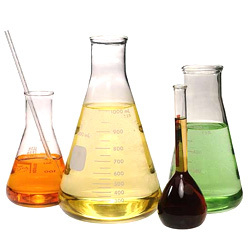
Erlenmeyer and volumetric flasks
BIOL 1406
PreLab 1.7
When measuring the volume of a liquid, how do I know which measuring device to use?
|
|
|
Erlenmeyer and volumetric flasks |
You will often be required to measure the volume of liquids in lab. The choice of a suitable device for measuring volume will depend on both the amount of liquid you want to measure, and the level of accuracy needed. In general, you should use the smallest measuring device available that is large enough to hold the volume of liquid you wish to measure. Using a measuring device several times (because it is too small to measure the full amount required) compounds errors in the measurement each time it is used. Conversely, using a measuring device that is too big also reduces accuracy.
![]() REMEMBER: When you measure water or aqueous solutions in beakers, flasks,
graduated cylinders, or pipettes, the top surface of the liquid will rise
slightly towards the edges, forming a curved surface called the meniscus.
You should always line up the lowest point of the meniscus with the
appropriate calibration mark on the measuring device. Make sure that your
eye is level with the meniscus, as well, so that the bottom of the meniscus
lines up properly with the calibration mark.
REMEMBER: When you measure water or aqueous solutions in beakers, flasks,
graduated cylinders, or pipettes, the top surface of the liquid will rise
slightly towards the edges, forming a curved surface called the meniscus.
You should always line up the lowest point of the meniscus with the
appropriate calibration mark on the measuring device. Make sure that your
eye is level with the meniscus, as well, so that the bottom of the meniscus
lines up properly with the calibration mark.
|
|
How do I choose the correct micropipettor to use? When using micropipettors, it is essential to choose the correct size for the job. Three sizes are available:
Click the play arrow on the left to watch a short video about how to select and use the appropriate micropipettor. If you have problems seeing the video, you can view it in an
External Viewer
|
![]() IMPORTANT: Never attempt to use a micropipettor to measure a
volume beyond the range it was designed to measure.
IMPORTANT: Never attempt to use a micropipettor to measure a
volume beyond the range it was designed to measure.
|
Use the interactive exercise below to practice how to choose and set the appropriate micropipettor to measure a given volume. |
| Your Turn | ||
|
Write 2 20 mL, 20 200 mL, or 100 1,000 mL to indicate which micropipettor should be used for each of the following measurements: |
||
| 50 mL | Hint | Check your answer. |
| 300 mL | Hint | Check your answer. |
| 0.015 mL | Hint | Check your answer. |
| 0.6 mL | Hint | Check your answer. |
| 1.0 mL | Hint | Check your answer. |
| 0.05 mL | Hint | Check your answer. |
| Your Turn | |
|
Assume that you have the following measuring devices available: 50 mL beaker 5 mL pipette 50 mL graduated cylinder 100 1,000 mL automatic pipettor 25 mL graduated cylinder 20 200 mL automatic pipettor 10 mL pipette 2 20 mL automatic pipettor Fill in the name of the device that will most accurately measure each of the following volumes. You can copy and paste the names from the list above. |
|
| 0.25 mL | Check your answer. |
| 37 mL | Check your answer. |
| 2.5 mL | Check your answer. |
| 0.08 mL | Check your answer. |
| 21 mL | Check your answer. |
| 8.5 mL | Check your answer. |
| 0.007 mL | Check your answer. |
| 0.016 mL | Check your answer. |
| 0.8 mL | Check your answer. |
| 0.04 mL | Check your answer. |
Close this browser window to return to Blackboard and complete the practice quiz and assessment quiz.